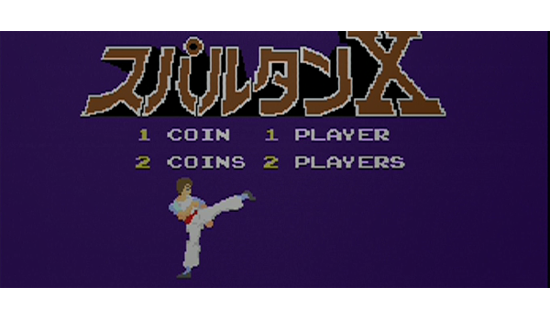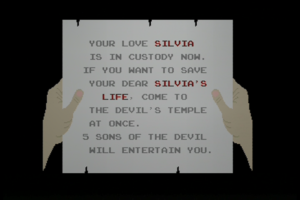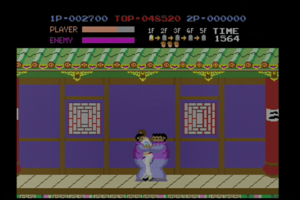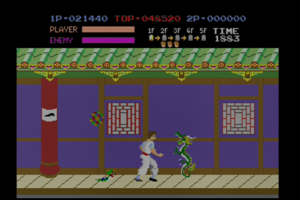Spartan X was an Irem developed arcade game in 1984, released overseas by Data East as “Kung-Fu Master”. It served as one of the earliest example of a side-scrolling “beat-em-up” game (or “belt scrolling action” in Japan), a genre that would absolutely blow up in popularity in both arcades and on consoles over the next several years. It’s safe to say that none of the many titles in the genre to follow couldn’t have existed without this one.
The premise is simple: You move the main character Thomas left and right (you can also crouch and jump) on a single plane to progress through a level, punching and kicking your way through groups of various types of enemies (regular martial artists, knife throwing martial artists, midgets, small snakes that burst from balls, and even moths that fly out of holes in the wall) and eventually level bosses (Or “Sons of the Devil”, as they were called in the arcade game, in which the story was just gold). You’ll do this over the course of the five floors of the “Devil’s Temple” until you reach Mr. X, who is holding Thomas’ girlfriend Sylvia hostage. After rescuing her you’ll get a brief ending, but you’ll then loop back through the game with increased difficulty, a number next to a dragon icon indicating which loop you’re on.
This game’s title came from a 1984 Sammo Hung written/directed movie starring Jackie Chan and Yuen Biao best known as “Meals on Wheels”, though it was released as “Spartan X” in Japan. Apart from the names of Thomas and Sylvia, the fact that it involves martial arts and the main character on the box art resembles a cartoon version of Jackie Chan, this game bears no resemblance to the movie in any way. It much more closely resembles the story in Bruce Lee’s “Game of Death” (an incomplete 1972 Hong Kong film which would be completed with stand-ins and released in 1978), in that the Spartan X game involves Thomas ascending floors of a temple and encountering a different martial arts master on each floor. It’s not clear whether this game existed before the Spartan X license was applied to it or not, but either way it seems to have made little difference. Game of Death was obviously the bigger influence here, despite the title.The designer of the original version was Takashi Nishiyama, known best at this point for designing another Irem arcade hit “Moon Patrol” (the first game to feature parallax scrolling) in 1982.
After designing Spartan X, Nishiyama would jump ship to Capcom where he would design some of their early arcade games such as Section Z, Trojan and Legendary Wings. His biggest achievement at Capcom though was undoubtedly co-directing the original Street Fighter with Matsumoto Hiroshi, thus solidifying the back-and-forth nature of ideas between beat-em-ups and fighting games that would continue to occur over time. Nishiyama conceived of the main character Ryu’s fireball, the Hadouken, citing that it was inspired by an energy missile attack called “Hadouhou” from the 1970s anime Space Battleship Yamato. By 1991 he had moved from Capcom to SNK where he would direct the first Fatal Fury game, then produce the other two in the series as well as several King of Fighters titles. Humorously, he would later end up as the President of Dimps, which would bring him back to the Street Fighter series with Street Fighter IV (Dimps were the developers of that title).
Playing the original arcade version of this game these days probably won’t impress too many these days. It’s not nearly as playable as the more well remembered NES/Famicom port due to the higher level of difficulty. Everything is just a tiny bit more punishing: Every hit takes more health, and coming into contact with a snake is instant death. But since we’re talking about an arcade game, a game designed to take money, that’s not all that surprising. The good part of that trade-off though, is better graphics and music than the aforementioned port.
Apart from tracking down an arcade board or just playing it emulated, there are a couple different ways of playing this.You can find it on Irem Arcade Classics on the PlayStation (also for download as a PSOne Classic on PS3 and PSP) or Saturn if you’re willing to import. The Irem Arcade Collection also features some niceties like difficult, energy decrease, number of lives (up to 5), and even an arranged version of the soundtrack (not that there’s very much to it).
There’s also an Irem Arcade Hits collection (which has a considerably greater number of titles than Irem Arcade Classics) for the PC and Mac in the US and Europe. If you’re more into retro American consoles various microcomputers you can find ports on the Atari 2600, Atari 7800, Commodore 64, Apple II, Amstrad CPC and MSX. It’s worth going back to if you want some quick fun or are interested in seeing the original beat-em-up.



